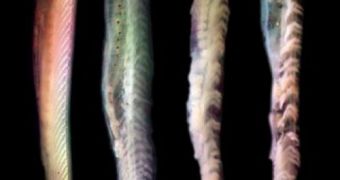Scientists have recently developed a new method of analyzing our ancestry, by studying fossils more than 500 million years old. This is apparently facilitated by studying modern, decomposing fish. It would seem that the rotting creatures help paleontologists gain new insight into how creatures on our part of the evolutionary tree may have looked like. Early investigations have already proven that some of the first animals to have ever roamed Earth's oceans were a lot more complex, at least in appearance, than first believed, e! Science News reports.
The team that conducted these investigations is based in the United Kingdom, at the University of Leicester Department of Geology. Details of their work appear in the January 31 issue of the Advance Online Publication (AOP) of the esteemed scientific journal Nature. The research was made possible through grant money secured from the Natural Environment Research Council (NERC). The UL team was led by Dr. Rob Sansom, who was also the lead author of the new paper.
“Interpreting fossils is in some ways similar to forensic analysis – we gather all the available clues to put together a scientific reconstruction of something that happened in the past. Unlike forensics, however, we are dealing with life from millions of years ago, and we are less interested in understanding the cause or the time of death. What we want to get at is what an animal was like before it died and, as with forensic analysis, knowing how the decomposition that took place after death altered the body provides important clues to its original anatomy,” the scientist says.
Sansom adds that the process of decomposition is, counter-intuitively, very important in determining the overall appearance of the earliest creatures. These animals are widely considered to be of tremendous importance to our evolutionary history, because they featured some of the organs that would later on become human traits, such as proto-backbones, eyes and Tails. “These fossils provide our only direct record of when and how our earliest vertebrate ancestors evolved. Did they appear suddenly, in an evolutionary explosion of complexity, or gradually over millions of years? What did they look like? In what ways did they differ from their worm-like relatives and how did this set the stage for later evolutionary events?” study co-leader Dr. Mark Purnell states.

 14 DAY TRIAL //
14 DAY TRIAL //